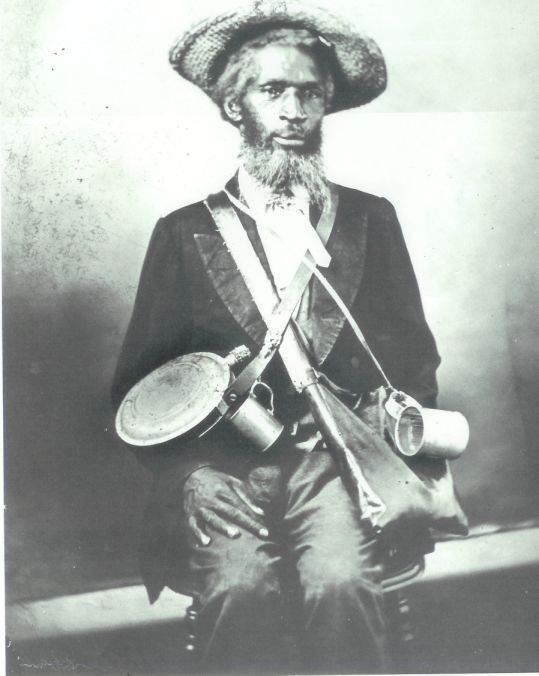Critical Analysis of the Examples
On the opposite side of the debate, professional historians Glatthaar, McPerson and Robert Krick have analyzed, between them, over 25,000 letters of soldiers, 1,500 manuscript collections, and Confederate service records of 150,000 soldiers, and have all encountered very few accounts of black soldiers.(20) Therefore, they see no reason to attach a large number to the individual blacks who took up arms occasionally.
 Clearly, a lot depends on the reading of accounts and
sources, otherwise there would not be such a different
result, with on both sides a similar confidence in one's
own findings. The most powerful argument that can be made
against the case of a significant number of blacks fighting
in the Confederate armies, and deriving a large number of
black soldiers of the accounts, is the fact that enlistment
of coloreds was simply prohibited by the Confederate
government. In fact, this, and the notion that secession
had been largely about the preservation of slavery and race
relations,(21) is why most historians dismiss the possibility
of large numbers of black Confederates.
Clearly, a lot depends on the reading of accounts and
sources, otherwise there would not be such a different
result, with on both sides a similar confidence in one's
own findings. The most powerful argument that can be made
against the case of a significant number of blacks fighting
in the Confederate armies, and deriving a large number of
black soldiers of the accounts, is the fact that enlistment
of coloreds was simply prohibited by the Confederate
government. In fact, this, and the notion that secession
had been largely about the preservation of slavery and race
relations,(21) is why most historians dismiss the possibility
of large numbers of black Confederates.
In his study of Confederate emancipation and the eventual enlistment of colored soldiers in the Southern army, Bruce Levine, professor of history at the University of California, argues that there cannot have been large units of black fighting men, because there was no societal foundation; the entire notion of letting blacks fight went against what the Confederacy stood for and struggled against. Indeed, that is why it took so long for the government to accept the possibility of colored enlistment. There may have been a few who championed the cause in order to save the Cause, but most were too stubborn.(22)
As stated before, in his own admission, Rollins relies heavily on anecdotal evidence, and so do the other authors. Anecdotal in itself need not necessarily work against an argument. In fact, the presence of women in armies-dressed up as men, or serving as spies-is not found in official records, either, yet they are treated as heroes who defied convention. They are recognized as exceptional, but are honored all the same.(23) Women, on the other hand, run much less the chance of being used as the poster child for the Confederate Lost Cause, and are more readily accepted than gun toting blacks.
These objections cast some light, if rather a shadow, on the proposed numer of 30,000 fighting blacks. It is, after all, questionable how one can calculate such a large number from scattered anecdotal evidence alone. Moreover, both amidst controversy and in communication, a number as large as 30,000 would have been noticed, if not abundantly, at least more frequently than the abovementioned Civil War historians have found.
Looking at the accounts more specifically, the loyal slave of Jordan's essay, who could not take an oath that his master would not take, may have exclaimed this for other reasons than mere loyalty: he could hardly declare openly that he would easily go against his master-who would never swear loyalty to the Union. Jordan's interpretation is therefore too simple. His southern angle is illustrated also in his continuous reference to slaves as "Afro-Virginians," which is both an anachronism as a misnomer: such a hyphenated epithet was unthinkable in the nineteenth century South, because blacks were not recognized (let alone acknowledged) as citizens.
Rollins' examples are also interpreted naively askew, for the black sniper had to choose between fighting or being sold away from his wife and family. Fighting for the South rather seems like a lesser of two evils than a sign of pride. General Gordon's remark about "strange stories" of a "Negro marksman" at Fort Wagner illustrates mainly that that the balance of blacks fighting for the Union and for the Confederacy is disproportionately out of kilter, as the 54th Massachusetts were on the other side.(24)
On a more scholarly note, the third example is accompanied by an incomplete footnote, making the story of Kelly untraceable.(25) In the same line, Rollins often relies on unclear accounts, attributed to "an observer" or "onlookers" who remain mostly unknown, partly because they were cited thus in newspaper articles, and partly because Rollins uses obscure sources.(26) A least obscure source he relies heavily on, is H.C. Blackerby's Blacks in Blue and Gray, which borrows extensively from accounts and articles of the post-war period.
Many anecdotes are rather ambiguous: a comparison between different accounts of the same scene often leads to different viewings. Soldiers in one story, the blacks involved in a skirmish are referred to as mere "teamsters" or servants in another.(27) There are other reasons for misinterpretation: southern soldiers were often filthy and sunburnt, and could easily be identified as being dark-skinned; also, blacks donning old uniforms, wearing their masters' guns could easily be viewed as soldiers.(28) For these reasons, the accounts and articles, specifically when written shortly after the Civil War, should be studied carefully for their right historical value.
Pensions, also, are not clear-cut evidence for the presence of black soldiers in Southern armies, because they were often awarded to a group that could be so broadly defined as to include the workers and body servants. In Virginia, for instance, pensions became eligible for anyone who "accompanied a soldier [...] or who served as a cook, hostler, or teamster, or who worked in breastworks under any command of the army."(29) Having accompanied the army, or even having been wounded, did not require being a soldier, actively fighting, or merely carrying a musket; all it took was being associated with the armed forces.
A final critique is aimed at the photos often used to illustrate both that blacks did serve in the armies of the South. Granting that photos do not lie, their usage brings several difficulties. A photograph cannot elaborate on the exact role of the blacks it portrays, or the position they fulfilled in the army: it merely illustrates proximity. At most, they deliver an incomplete story, and conclusions drawn from them should be tentative.
